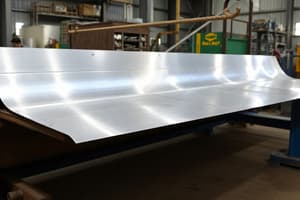Podcast
Questions and Answers
What is the primary difference between cold forming and hot forming?
What is the primary difference between cold forming and hot forming?
Cold forming does not involve heating the metal, while hot forming involves heating the metal to a high temperature before forming it.
What are the three primary methods used for cutting in sheet metal fabrication?
What are the three primary methods used for cutting in sheet metal fabrication?
Laser cutting, plasma cutting, and shearing.
What is the purpose of bending in sheet metal fabrication?
What is the purpose of bending in sheet metal fabrication?
To create the desired angles or curves in the metal.
What is the final step in sheet metal fabrication?
What is the final step in sheet metal fabrication?
What is the primary purpose of metal forming?
What is the primary purpose of metal forming?
What are the two primary methods of metal forming?
What are the two primary methods of metal forming?
What is the primary advantage of laser cutting in sheet metal fabrication?
What is the primary advantage of laser cutting in sheet metal fabrication?
Which cutting method is suitable for cutting thicker materials and complex shapes?
Which cutting method is suitable for cutting thicker materials and complex shapes?
What is the main purpose of metal finishing in sheet metal working?
What is the main purpose of metal finishing in sheet metal working?
What is the process of powder coating?
What is the process of powder coating?
What is anodizing used for?
What is anodizing used for?
What is the main difference between electroplating and other metal finishing methods?
What is the main difference between electroplating and other metal finishing methods?
Study Notes
Sheet Metal Working
Sheet metal working involves the manipulation of thin, flat pieces of metal using various fabrication techniques to create parts for various industries. This article will cover the subtopics of metal forming, sheet metal fabrication, cutting methods, and metal finishing.
Metal Forming
Metal forming is the process of permanently deforming metal to create a desired shape. The two primary methods of metal forming are:
Cold Forming
Cold forming is the process of creating a final shape by deforming a metal part without heating it. Techniques include deep drawing, stretching, forming, and bending.
Hot Forming
Hot forming involves heating the metal to a high temperature and then forming it into the desired shape. This method is often used for more complex shapes and is suitable for metals with high strength and hardness.
Sheet Metal Fabrication
Sheet metal fabrication involves various processes to create metal parts from raw materials. These processes include:
- Cutting: The metal is cut to the desired shape using various methods such as laser cutting, plasma cutting, or shearing.
- Bending: The metal is bent to create the desired angles or curves using tools like press brakes or rolling machines.
- Welding: The metal is joined together using various welding techniques such as MIG, TIG, or resistance welding.
- Assembly: The fabricated parts are assembled to create the final product.
Cutting Methods
Several cutting methods are used in sheet metal fabrication:
Laser Cutting
Laser cutting uses a high-powered laser to cut through metal sheets. It offers high precision and can cut a wide range of materials.
Plasma Cutting
Plasma cutting uses a high-temperature ionized gas to cut through metal sheets. It is suitable for cutting thicker materials and can handle more complex shapes.
Shearing
Shearing involves pressing a sharp blade through the metal sheet to cut it. It is a fast and cost-effective method for cutting large quantities of sheet metal.
Metal Finishing
Metal finishing is the process of applying a coating or surface treatment to the metal to improve its appearance, durability, or functionality. Common finishing methods include:
- Powder Coating: A dry coating applied as a powder, which is then heated to melt and flow over the surface of the metal.
- Anodizing: An electrochemical process that forms a hard, corrosion-resistant oxide layer on the surface of aluminum or titanium.
- Painting: Applying a liquid paint to the metal surface, which can be done manually or using automated robots.
- Electroplating: Applying a thin layer of metal (such as gold, silver, or nickel) to the surface of the metal using an electric current.
In conclusion, sheet metal working plays a crucial role in manufacturing various products across different industries. By understanding the processes involved in metal forming, sheet metal fabrication, cutting methods, and metal finishing, we can appreciate the complexity and precision required to create high-quality metal parts.
Studying That Suits You
Use AI to generate personalized quizzes and flashcards to suit your learning preferences.
Description
Explore the world of sheet metal working, covering metal forming, sheet metal fabrication, cutting methods, and metal finishing. Learn about various techniques and processes used to create high-quality metal parts for various industries.




